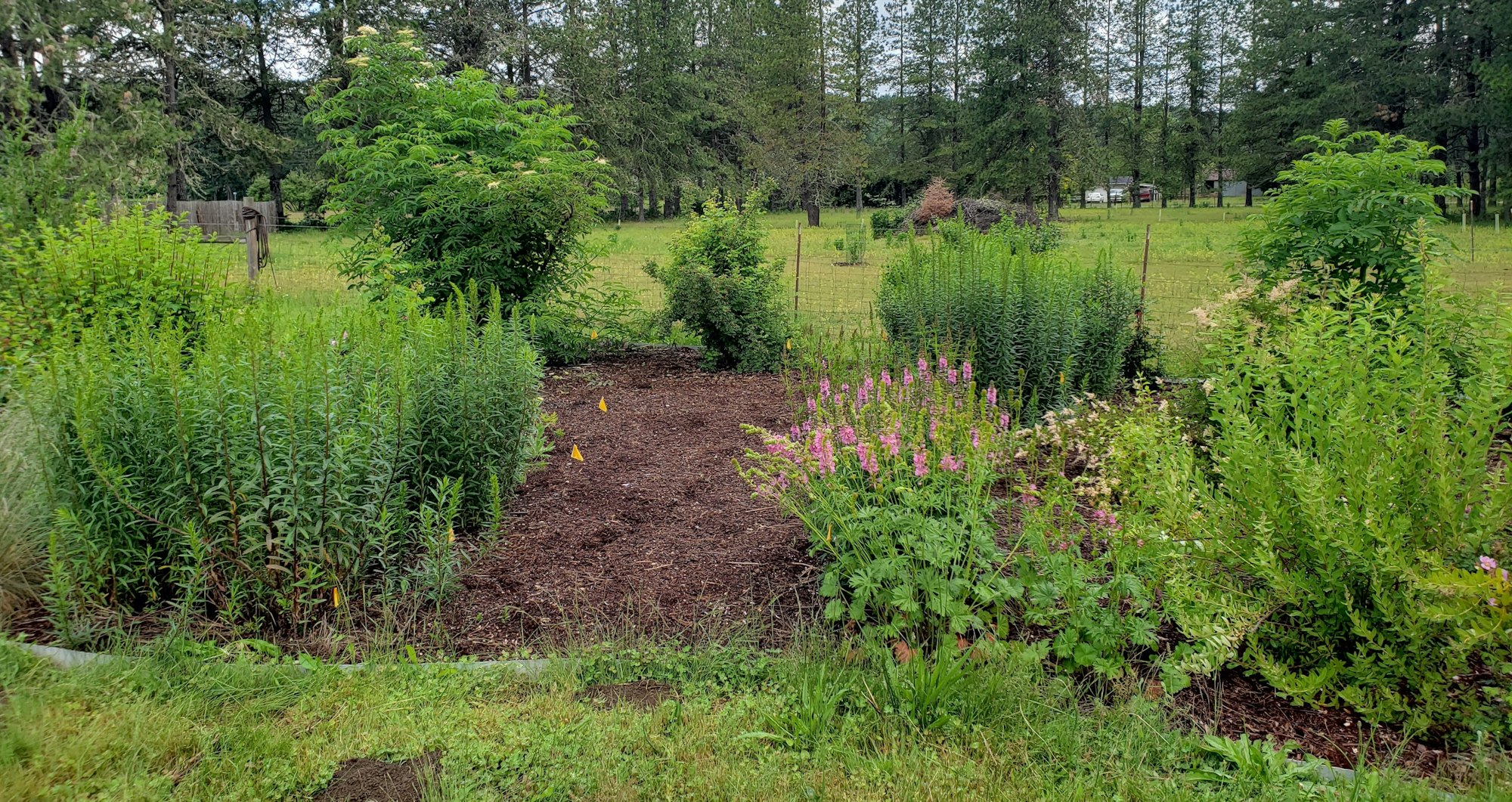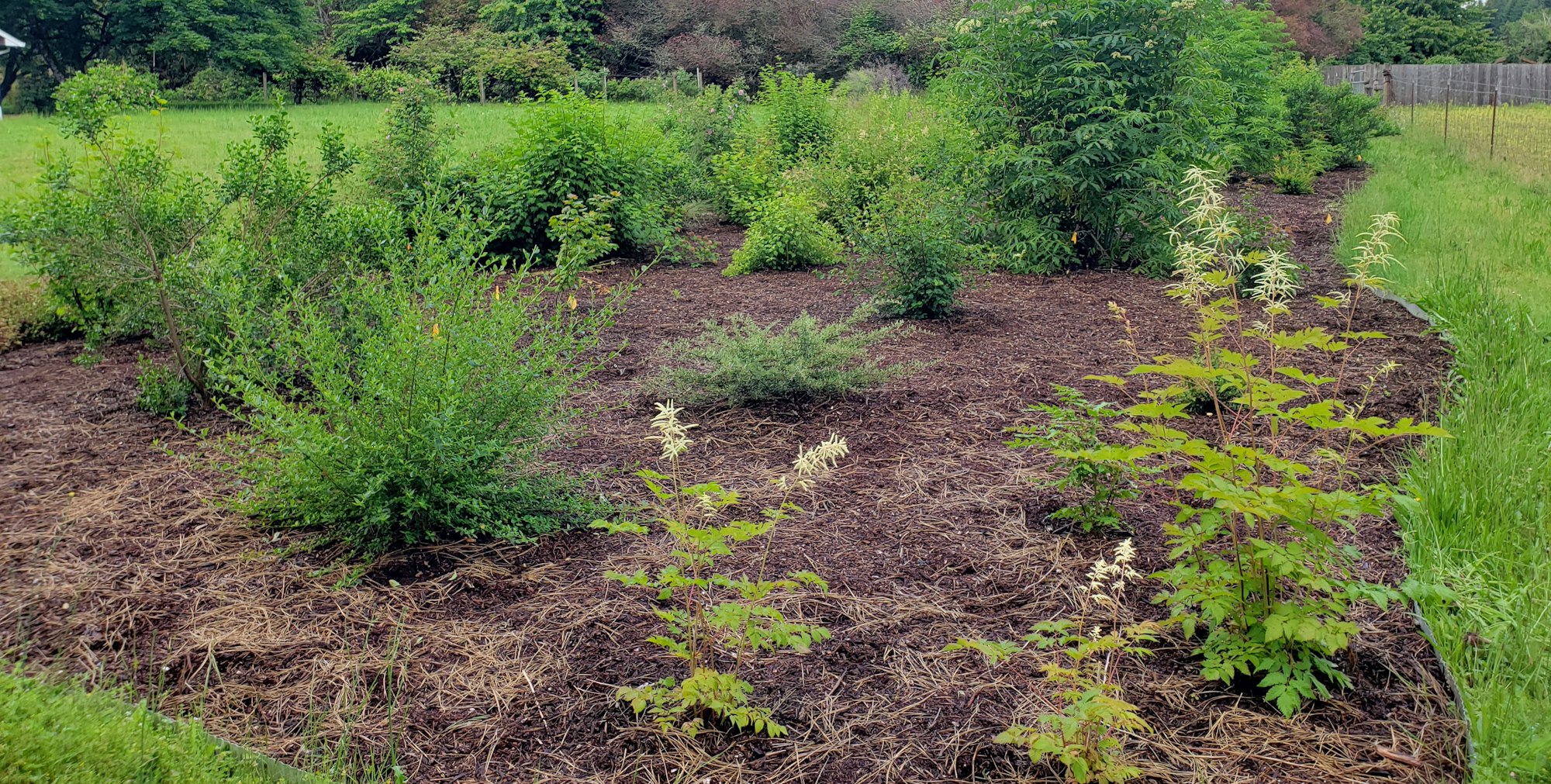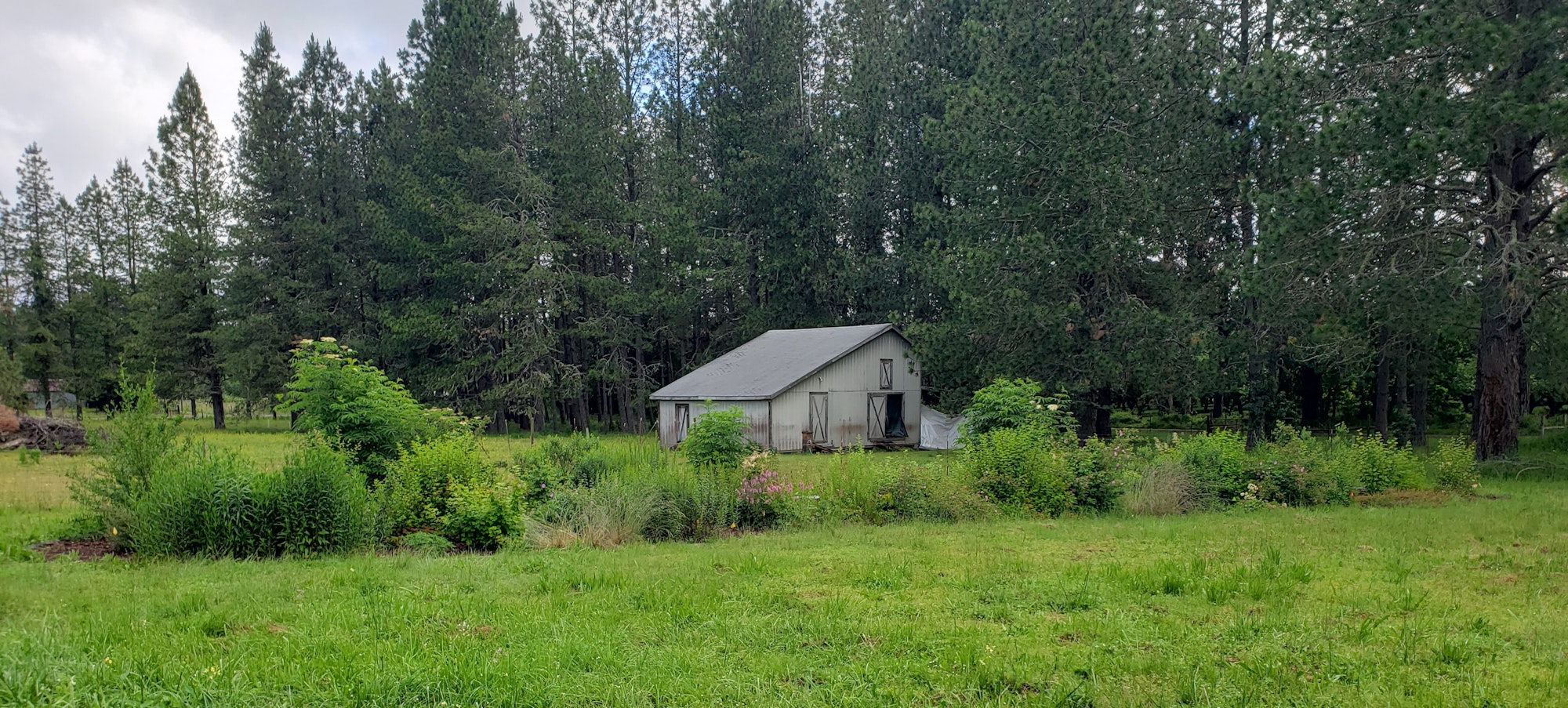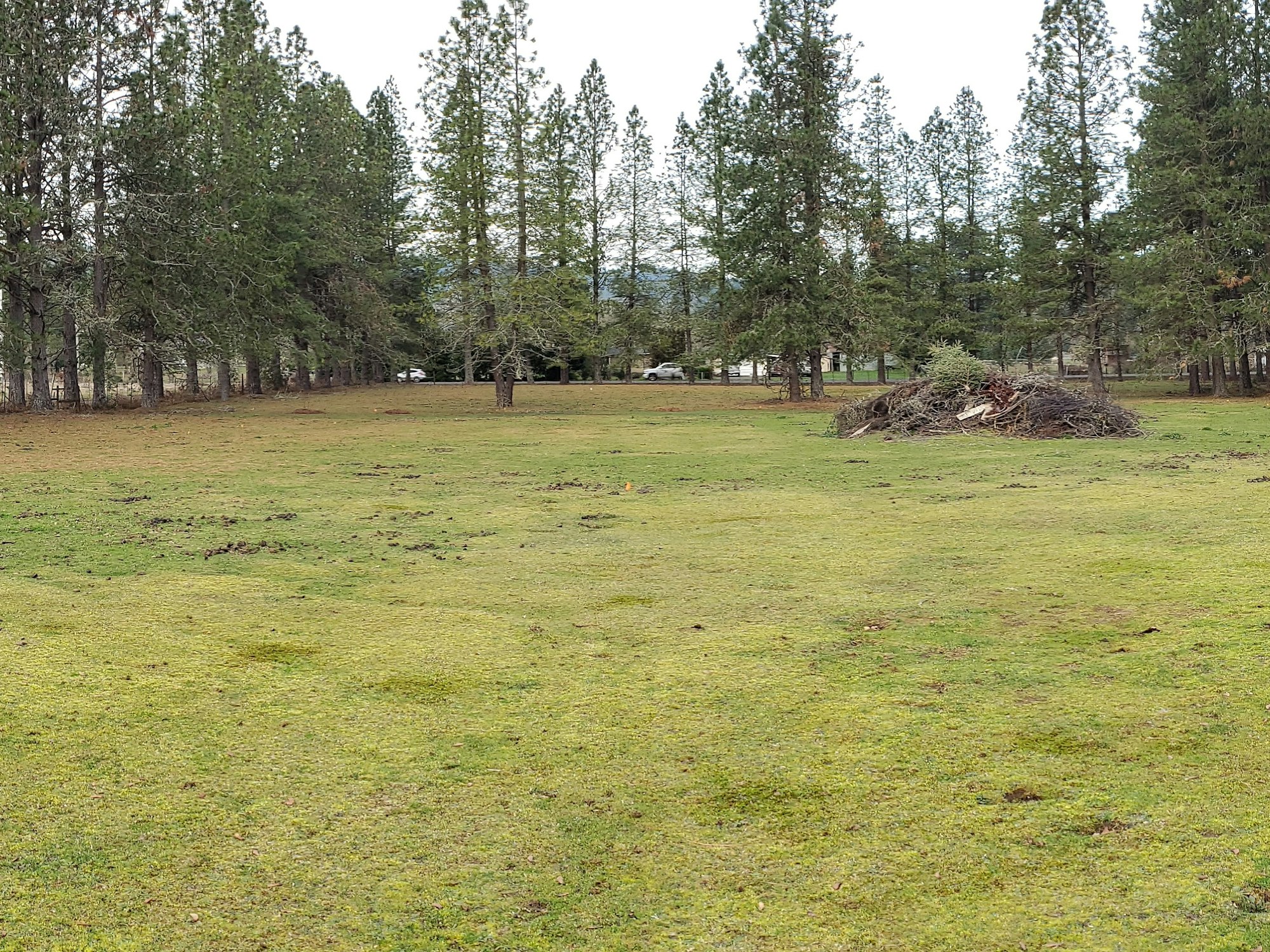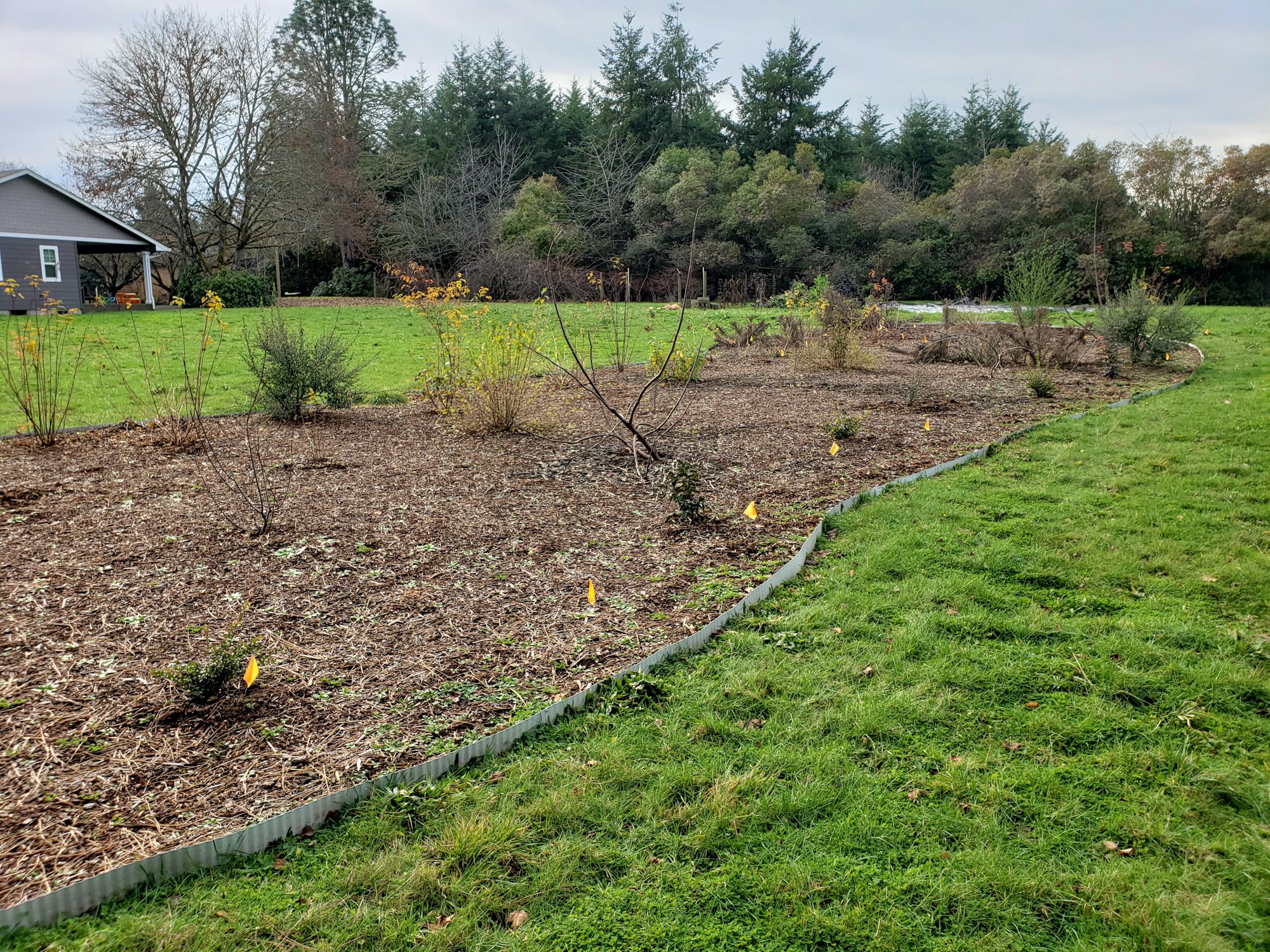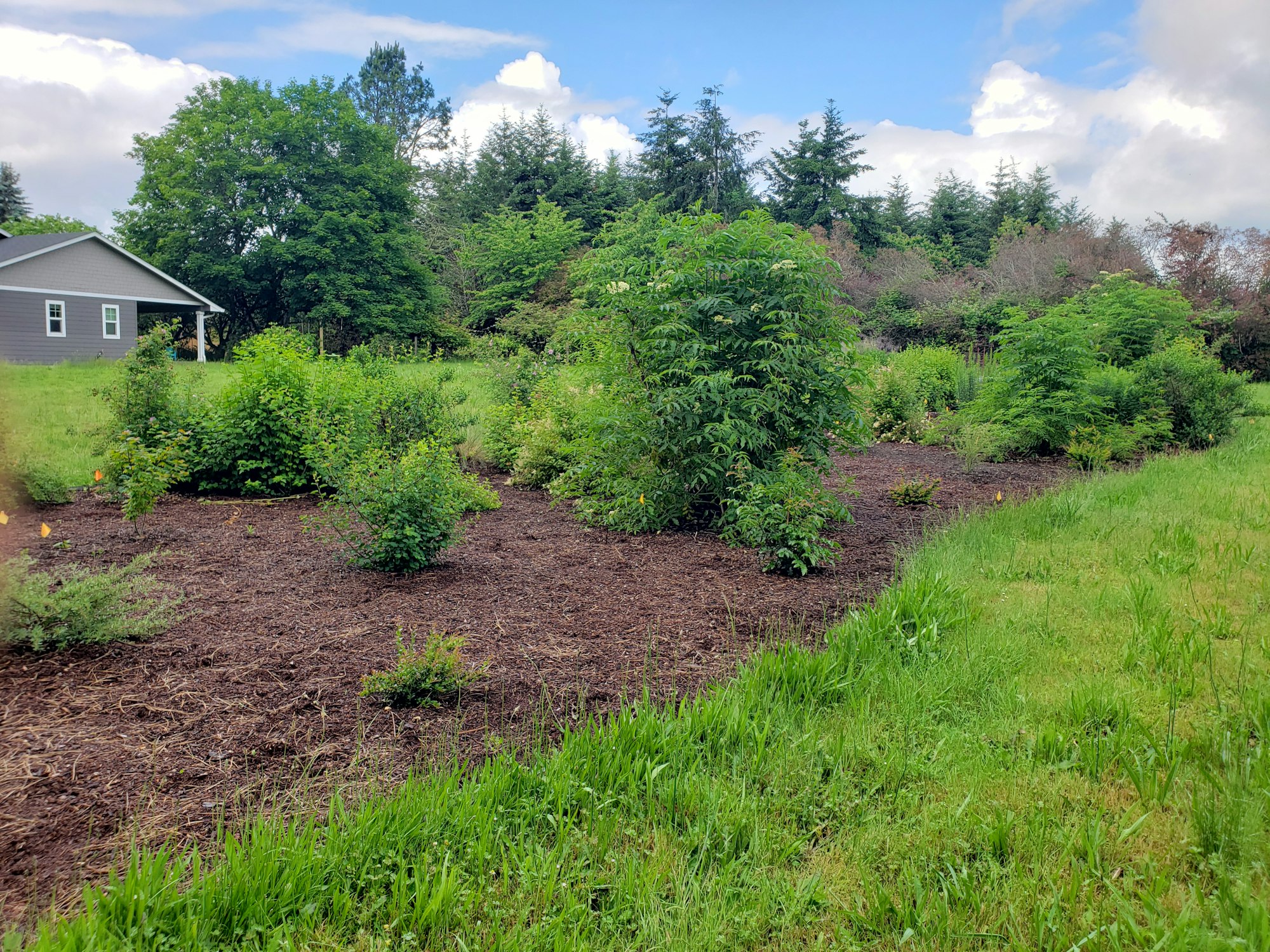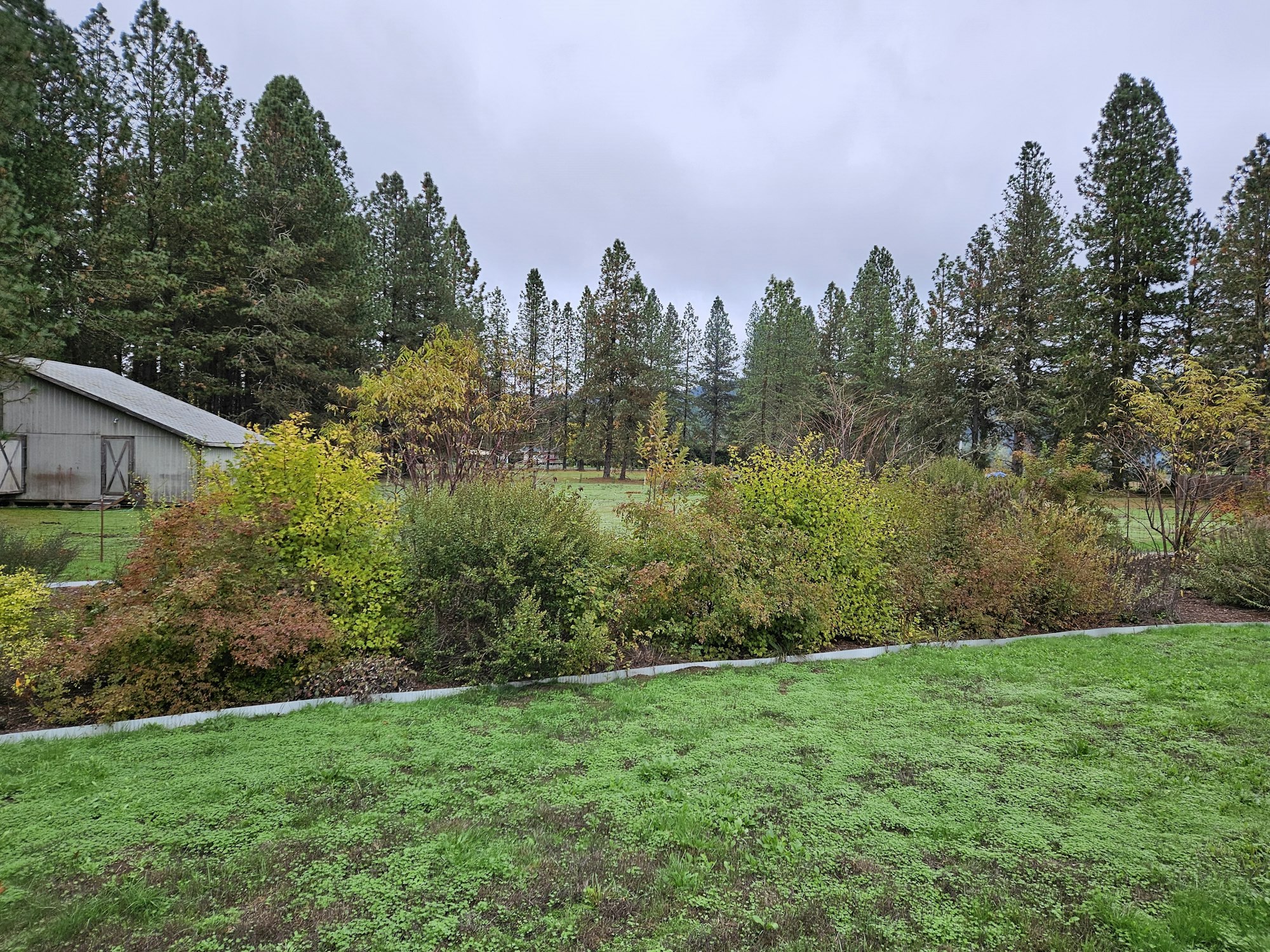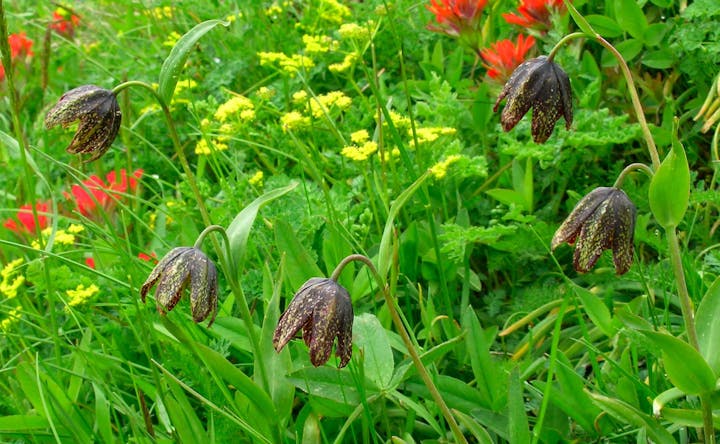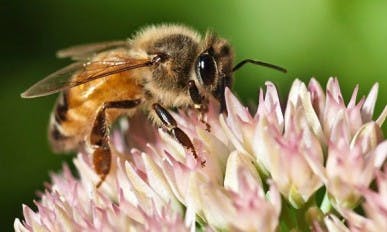Native Plantings - Share Your Experience!
A Virtual Interview with Native Plant Sale customer, Tom Hagen
By Teresa Matteson, Resource Conservationist
December 20, 2023
Over the years, Native Plant Sale (NPS) customers frequently email questions to our staff about their orders and share comments about their gardening projects. Often, we forge ties with people who share their planting experience. Their trial, error, and success stories showcase their love of native plants and the wildlife the plants attract. These stories also help BSWCD staff better understand how to serve NPS customers.
Meet Tom Hagen, one such NPS customer who first bought plants from us in 2021. Tom lives on five acres west of Eugene, near Fern Ridge Reservoir in Lane County. Tom reached out with questions before he picked up his first NPS order, and emailed photos of his native planting each year.
When Tom recently emailed photos from last summer, I was thrilled to see how well his garden had grown. Thinking that his experiences would benefit other customers, I requested permission to post his photos and we exchanged emails to create a “virtual interview”. For more information on Tom’s native planting adventure, read on!
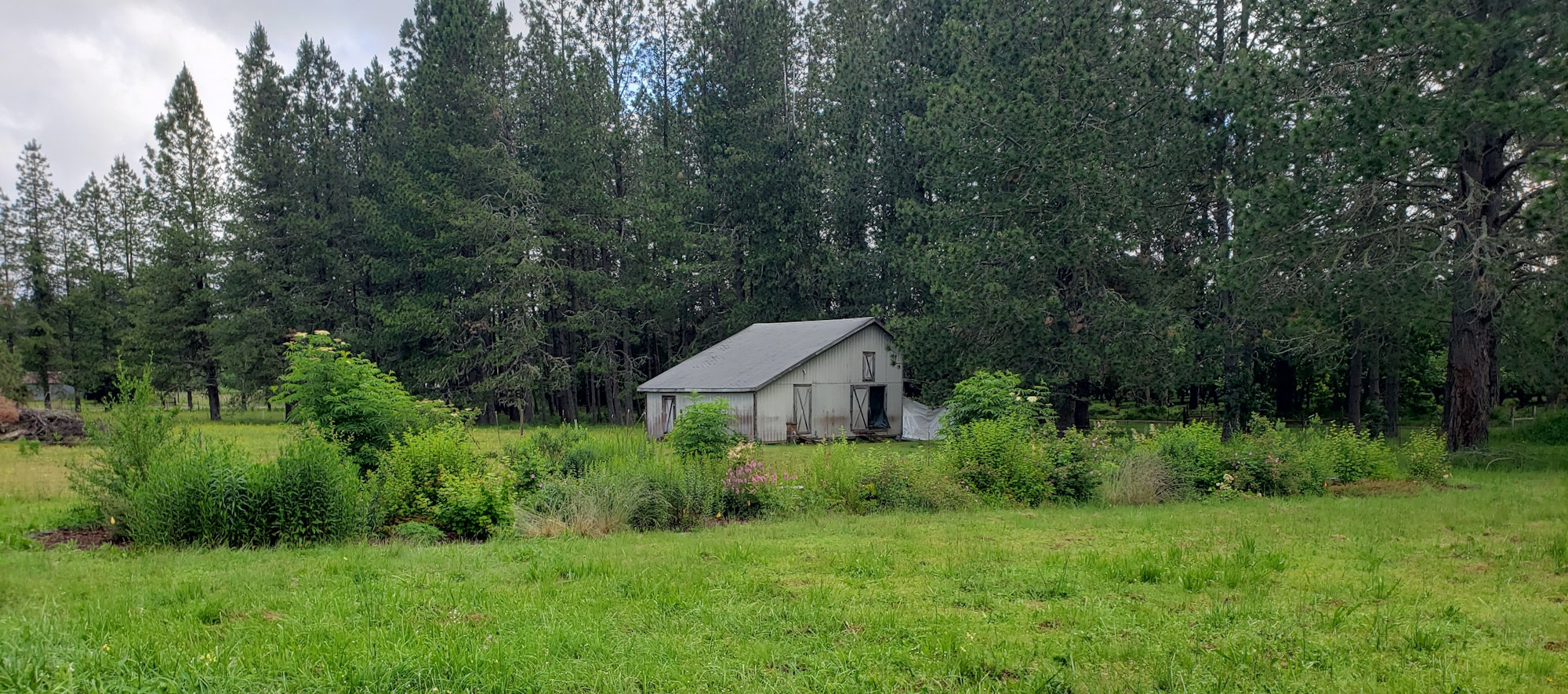
Matteson: How did you get interested in native plants for your property? What inspired you to dedicate land to natives?
Tom Hagen: I first became interested in native plants and wildlife conservation about 5 or 6 years ago. I came across a YouTube video of a talk by Dr. Douglas Tallamy on the dire straits of our native plant ecosystems and wildlife food chains, in particular the decrease in native host plants for moth and butterfly caterpillars. These caterpillars are the primary food source for the vast majority of our native birds, and so in order to re-establish and maintain this food source for birds we need to plant native plants that our moths and butterflies will use to lay eggs on. I have to admit, I've probably watched 20-30 of Dr. Tallamy's presentations based on his various books and research. It really is a powerful message he's giving. I plan on planting natives until I run out of room!
Matteson: Some restoration projects figure in a 2-year site prep period to get rid of competition from grasses, weeds, etc. Describe the preparation you made in the area before you started. Did you remove any plants (blackberries, etc.) or spray out grasses? How much time was spent on preparing the site?
Hagen: For my hedgerow prep I placed black plastic sheeting over a 100'x30' rectangular area. I didn't have brush or blackberries to contend with, just grass and weeds. I then cut out a more organic shape into the rectangle and removed the excess plastic, leaving just the shape I wanted for the finished hedgerow. After fastening it [the plastic] to the ground I left it there for about 8 months leading up to the planting time, [that was] right after the February native plant pick up. The heat from our summer months baked the vegetation under the plastic and it was my hope that any remnant weed seeds would be destroyed as well. I believe it worked pretty well. I then hammered in 6" tall, corrugated metal edging (3" above and below the soil level) around the entire perimeter to deter weeds from creeping in and to keep mulch inside the hedgerow. Next, I had the chunkiest bark mulch I could buy, blown in by truck to the top of the edging. It was now ready to plant.
I sheet-mulch around each plant using four pieces of overlapping cardboard or paper bags, one on each side of the plant, up to about 4" away from the base of the stem/trunk. Then I will put the mulch onto that as one more barrier against weeds. I have used two types of mulch for my native plantings. The first type, as you noticed, is the heaviest/chunkiest wood/bark mulch I can find. My reasoning for that is that it seems to take longer to break down, negating the need to replenish the mulch so often. I have yet to replace any mulch in my hedgerow and some of the larger deciduous shrubs are already creating enough leaf litter that I don't think I'll ever need to [add more mulch] for the majority of the plot.
The second type of mulch I've used is pine needles from the ponderosa pine trees on my property. I used a rake and just gathered them up creating a ring-like shape around my plantings. My reasoning for using the pine needles was two-fold. Firstly, they were free and prevalent and at certain times I was out of bark mulch so I used what I had available. The second reason was more experimental in nature, in that I wanted to see if using a local/natural mulch just as it would fall to the ground in nature, would work as well as processed (although still natural) bark mulch. So far it seems like both mulches work well with no mulch being clearly better than the other.
My mulch layer is usually 8-10" at its deepest and tapers to ground level around 2" or so from the stem/trunk of the plant. I have never used any compost or fertilizer with any of my native plantings. I find that using a really thick mulch layer holds in moisture the best and also helps combat weeds better than a less deep mulch layer.
Matteson: Did you amend the soil before planting?
Hagen: No, amendments were not made to the soil. I wanted the plants started entirely in my native soil and used to it from day one.
Matteson: How much time do you spend on maintenance?
Hagen: Once during the Fall and once during the Spring I use a scuffle hoe to knock down any weeds that have germinated inside the hedgerow. Additionally, during the summer months while walking around I will occasionally pull up anything I see poking up through the mulch. As the plants grow and cover up open areas within the hedgerow, my need for weeding decreases. I don't really prune as I want everything to fill out and behave naturally, however in the springtime I have cut back some of the perennials to about 18" from the ground to make room for new growth while still leaving part of the old hollow stems for nesting native bees. I do this with goldenrod, aster, goatsbeard, blanketflower, and checkermallow. These are the only long-stemmed perennials I have planted in the hedgerow. Also, I don't use any herbicide or insecticide anymore on my property.
Matteson: How much do you or have you watered the planting?
Hagen: I watered every plant heavily, immediately after planting in February. I let rain do the rest until after our summer drought sets in, usually in early summer. Then every 2-3 weeks I will water each plant thoroughly.
After the plants have been in for two years, I let nature take its course. Only during extreme heat do I water the plants that like a little extra moisture such as: vine maple, goatsbeard, checkermallow, Douglas spirea, cascara, quaking aspen, etc. My only exception is with Ceanothus. I water them in initially and then leave them alone. They're extremely drought tolerant and too much water can shorten their lifespan or even kill them.
Matteson: What is your favorite native plant and why?
Hagen: I think blueblossom Ceanothus (Ceanothus thyrsiflorus) is my favorite native plant right now, even though it isn't native in the strictest sense of the term. I believe they grow naturally a little further south in Oregon and more coastal. However, they are resilient, evergreen, grow very quickly and have a fantastic profusion of blooms in the spring that insects love. Birds eat the seeds and many butterflies and moths supposedly use the foliage of Ceanothus as a host plant for caterpillars. I haven't seen any caterpillars on my blueblossoms yet, and I'm unsure if that's due to my plants being slightly outside their true native range or because butterflies and moths just haven't found my particular plants yet. Or quite possibly, I just haven't noticed them, as these shrubs can turn into small trees!
Matteson: What is your long-term goal for the planting? Pollinator habitat, wildlife habitat, beautification of your land, less maintenance, etc.
Hagen: Pollinator and wildlife habitat are my primary goals. This hedgerow has the added benefit of reducing the size of my unproductive lawn as well. I believe that the hedgerow, and hopefully my field plantings as well will beautify the land. I feel like the hedgerow has created a nice screen between my home and the street along the front of my property. It reduces noise as well as provides a visual break from vehicle traffic.
Matteson: Have you noticed an increase in birds or insects that visit the planting?
Hagen: I have noticed many birds and insects utilizing the hedgerow. Birds that I have seen so far include: sparrows, finches, towhees, chickadees, and jays. Many insects have visited the hedgerow as well, including a large variety of bees and even some caterpillars which I was happy to see. Yesterday, I even saw three gray squirrels running around amongst the native plants in my hedgerow and a neighboring ponderosa pine.
Matteson: What lessons have you learned? What would you do differently? What did you do right?
Hagen: I learned that deer and livestock, my horse in particular, can do a lot of damage to new plantings. Some plants require plant protectors if you have deer around. If you’re planting around livestock, you may need to use chicken wire that's tightly woven and won’t let anything near the plant. I've tried using cattle fencing to make homemade protectors and it left openings large enough to allow my curious horse to push them completely over to get at the plants inside. Deer aren't nearly as tenacious in my experience and can usually be turned away with simple plastic mesh protectors.
I have found certain plants really benefit from plant protectors as well. I've had trouble with deer eating the following plants in particular: willows, oceanspray, cascara, Indian plum, quaking aspen, oaks, maples, and mock orange.
I have found that deer and animals tend to stay away from the smaller-leaved evergreens as well as thorny plants such as: Ceanothus, coyote bush, roses, Oregon grape, and evergreen huckleberry. Everything else seems to be fair game.
I've also learned that native roses, especially Nootka roses can be particularly aggressive, which can be a good thing if you’re looking to create habitat quickly. It does, however, send runners up all over the place and can quickly bully neighboring plants in tight spaces. They even send runners under edging material and up through grass as I’m finding out! One thing in general that I'm glad I did in my hedgerow, roses aside, was to plant natives in relatively close proximity to one another to quickly cover exposed ground to prevent weeds from taking over. This creates more protection and cover for wildlife as well. It’s definitely okay that the plants are touching one another to create a more "natural" setting or landscape for wildlife to explore. Annual leaf litter should mulch the plants from now on.
Matteson: Other thoughts you would like to share with a reader?
Hagen: I'm very glad that I took the plunge and created a native hedgerow. It was quite a lot of work, but it was enjoyable work, and I love watching wildlife utilize and live in the habitat that I created for them. I also love watching the plants grow more and more each year. I try to take time every so often, sitting in a lawn chair inside the hedgerow just watching and listening to nature. There really is so much activity and life there in the same exact spot that had relatively no life at all before I planted native plants in that area just a couple of years ago.
Additionally, the native plant sale through Benton Soil and Water truly made my project feasible as it offers so many varieties of plants at very affordable prices. If I were to purchase the same plants that I used in my hedgerow from a native plant nursery, it would have been many hundreds of dollars and I would have never been able to create it. I hope the native plant sale continues on, as that is what allows regular folks such as myself to create a decent sized habitat at a reasonable cost.
Thanks for indulging my urge to educate others. - Tom Hagen
Do you want to create a native hedgerow like Tom? Check out the resources on the right, and be sure to shop our Winter Plant Sale until February!

